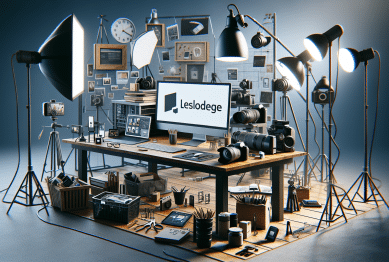In an era dominated by digital noise and nonstop notifications, the tools we use to think, create, and solve problems are under more scrutiny than ever. As demands for cognitive clarity rise, a countertrend is quietly taking shape—quiet productivity tools are becoming a serious contender in the conversation about focus and mental performance.
These tools—ranging from distraction-free writing apps to analog planners and minimalist browsers—are intentionally designed to reduce inputs, simplify environments, and amplify intentional thought. Their growing popularity reflects a shift in how we relate to productivity: from maximizing output to cultivating clarity.
This article explores why quiet tools amplify thought, highlights emerging trends, and offers practical recommendations for integrating these tools into daily workflows.

What Are Quiet Productivity Tools?
Quiet tools are designed to create space rather than fill it. They often have limited features, clean interfaces, and little to no integrations. Some are digital, while others are physical. But all share one principle: reduce friction to deepen focus.
Examples include:
- Distraction-free writing apps like iA Writer or FocusWriter
- Minimalist browsers like Arc or Min
- Offline tools like Hobonichi planners or the Analog productivity system
- Noise-reducing technologies like Krisp for calls or smart noise-cancelling headphones used during deep work blocks
Rather than add complexity, these tools subtract it—helping thinkers, writers, designers, and developers maintain sustained attention in a distracted digital ecosystem.
Why Quiet Tools Matter More Than Ever
1. Digital Overload Is the New Norm
The average knowledge worker receives 121 emails and is interrupted every 3 minutes, according to a study by RescueTime. Each interruption triggers a cognitive reset, breaking the flow of thought and weakening short-term memory consolidation. Tools that reduce interruptions don’t just protect time—they protect thought architecture.
2. Multitasking Reduces Mental Clarity
Research from Stanford University showed that frequent multitaskers perform worse on memory and task-switching tests compared to those who work sequentially. Quiet tools often limit multitasking by design, nudging users into single-focus workflows that support deeper cognitive performance.
3. Minimalism Isn’t Aesthetic—It’s Functional
Minimal design has gained traction not just as an aesthetic trend but as a functional response to cognitive overload. A 2021 study published in Nature Human Behaviour found that humans tend to add rather than subtract elements in problem-solving. Quiet tools reverse this default, fostering environments where fewer variables support sharper thinking.
Emerging Trends in Quiet Productivity Tech
1. Offline-First Workflow Tools
Apps like Obsidian and Logseq are gaining traction among thinkers who want local-first, markdown-based tools with no cloud dependency. Offline capability enhances not only data sovereignty but also eliminates background sync distractions and load times that subtly fragment focus.
2. Hardware-Based Cognitive Boundaries
New analog systems—like the reMarkable tablet or even custom notepads—are being embraced as cognitive boundaries: tools that resist notification creep, allow sketching and handwriting, and provide a tactile buffer from the chaos of open tabs.
3. Purpose-Built Single-Task Apps
Developers are now building tools with intentional limitations. For instance:
- Flowstate deletes your writing if you stop typing for more than five seconds—a brutal, yet compelling, focus booster.
- Cold Turkey Writer locks you out of everything else until a writing goal is reached.
These tools aren’t designed to scale. They’re designed to contain. And that’s exactly what makes them powerful.
How Quiet Tools Amplify Thought: A Cognitive Science Perspective
Quiet productivity tools align with several core principles of cognitive psychology:
- Cognitive Load Theory suggests that working memory is easily overwhelmed by extraneous stimuli. Tools that simplify visual environments reduce the “germane load” and free up more mental bandwidth for conceptual work.
- Flow Theory, developed by Mihaly Csikszentmihalyi, emphasizes the need for uninterrupted focus to achieve optimal productivity and fulfillment. Quiet tools help users reach and sustain this state.
- Extended Mind Theory (Clark & Chalmers, 1998) proposes that thinking isn’t confined to the brain. Tools, when well-matched, become part of our cognitive process. Quiet tools—especially tactile or minimal ones—serve as external stabilizers for internal complexity.
How to Integrate Quiet Tools Into Your Workflow
Adopting quiet tools doesn’t mean abandoning tech. It means choosing technology that respects your attention. Here’s how to start:
1. Audit Your Current Setup
Ask:
- Which tools generate the most notifications?
- What apps encourage multitasking or frequent tab-switching?
- Where does your mind feel most scattered?
2. Replace, Don’t Just Remove
Removing noisy tools without replacing them can leave a productivity vacuum. Instead, substitute with quieter alternatives:
- Replace a full-featured notes app with Simplenote
- Replace Zoom with audio-only Yac for internal standups
- Replace your calendar app with something minimalist like Sunsama
3. Schedule “Quiet Blocks”
Use a tool like Clockwise to automatically protect deep work time. Pair this with offline tools or apps in Focus Mode (macOS) or Zen Mode (VS Code).
4. Start the Day with Analog
Use a paper journal or daily planner to set intentions before opening a device. Studies show that analog writing improves memory encoding and reduces stress.
Who’s Using Quiet Tools?
- Writers and academics are returning to distraction-free writing environments like Scrivener or Ulysses.
- Designers use analog sketchpads or digital tablets without browser access during creative ideation.
- Developers run code in minimalist IDEs or with terminal-only tools to maintain keyboard-driven momentum.
- Remote teams are adopting asynchronous audio updates over video meetings to reduce cognitive drain and screen fatigue.
These aren’t Luddites. They’re technologists and creatives who are designing their digital environments as intentionally as their physical ones.
Quiet Tools Aren’t Slower—They’re Smarter
Choosing quiet tools isn’t about nostalgia or anti-tech sentiment. It’s about precision. Every toggle, ping, and update demands mental energy. In knowledge work, clarity isn’t a luxury—it’s a competitive advantage.
The quiet tool movement represents a larger trend toward intentional computing—a future where we design digital environments that support, not sabotage, our thinking.
Conclusion
In a landscape full of apps competing for your attention, the most powerful tools may be the ones that step back and let your mind do the work. As more people reevaluate their relationship with technology, quiet tools offer a path not only to increased focus—but to deeper thought, sharper creativity, and a better understanding of how we think best.
Whether you’re an entrepreneur, a student, a writer, or a developer, now is the time to ask: Is your tech stack serving your mind—or scattering it?
Choose quiet. It might be the smartest thing you do all year.
References
- RescueTime. How interruptions and context switching affect productivity.
https://blog.rescuetime.com/context-switching/ - Mark, G., Gudith, D., & Klocke, U. (2008). The cost of interrupted work: More speed and stress.
https://dl.acm.org/doi/10.1145/1357054.1357072 - Ophir, E., Nass, C., & Wagner, A. D. (2009). Cognitive control in media multitaskers.
https://www.pnas.org/doi/10.1073/pnas.0903620106









